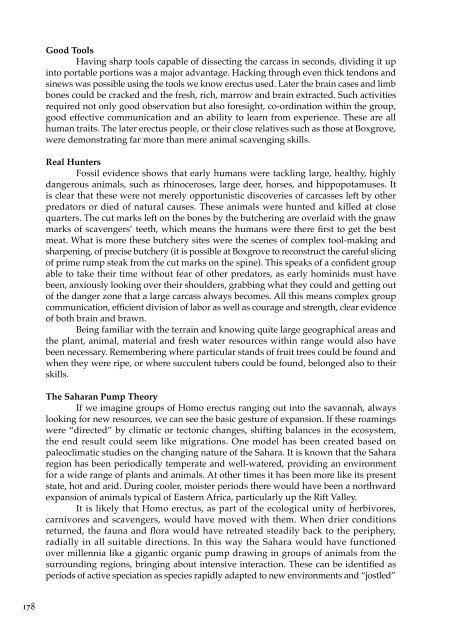The Spirit in Human Evolution - Waldorf Research Institute
The Spirit in Human Evolution - Waldorf Research Institute
The Spirit in Human Evolution - Waldorf Research Institute
You also want an ePaper? Increase the reach of your titles
YUMPU automatically turns print PDFs into web optimized ePapers that Google loves.
Good Tools<br />
Hav<strong>in</strong>g sharp tools capable of dissect<strong>in</strong>g the carcass <strong>in</strong> seconds, divid<strong>in</strong>g it up<br />
<strong>in</strong>to portable portions was a major advantage. Hack<strong>in</strong>g through even thick tendons and<br />
s<strong>in</strong>ews was possible us<strong>in</strong>g the tools we know erectus used. Later the bra<strong>in</strong> cases and limb<br />
bones could be cracked and the fresh, rich, marrow and bra<strong>in</strong> extracted. Such activities<br />
required not only good observation but also foresight, co-ord<strong>in</strong>ation with<strong>in</strong> the group,<br />
good effective communication and an ability to learn from experience. <strong>The</strong>se are all<br />
human traits. <strong>The</strong> later erectus people, or their close relatives such as those at Boxgrove,<br />
were demonstrat<strong>in</strong>g far more than mere animal scaveng<strong>in</strong>g skills.<br />
Real Hunters<br />
Fossil evidence shows that early humans were tackl<strong>in</strong>g large, healthy, highly<br />
dangerous animals, such as rh<strong>in</strong>oceroses, large deer, horses, and hippopotamuses. It<br />
is clear that these were not merely opportunistic discoveries of carcasses left by other<br />
predators or died of natural causes. <strong>The</strong>se animals were hunted and killed at close<br />
quarters. <strong>The</strong> cut marks left on the bones by the butcher<strong>in</strong>g are overlaid with the gnaw<br />
marks of scavengers’ teeth, which means the humans were there first to get the best<br />
meat. What is more these butchery sites were the scenes of complex tool-mak<strong>in</strong>g and<br />
sharpen<strong>in</strong>g, of precise butchery (it is possible at Boxgrove to reconstruct the careful slic<strong>in</strong>g<br />
of prime rump steak from the cut marks on the sp<strong>in</strong>e). This speaks of a confident group<br />
able to take their time without fear of other predators, as early hom<strong>in</strong>ids must have<br />
been, anxiously look<strong>in</strong>g over their shoulders, grabb<strong>in</strong>g what they could and gett<strong>in</strong>g out<br />
of the danger zone that a large carcass always becomes. All this means complex group<br />
communication, efficient division of labor as well as courage and strength, clear evidence<br />
of both bra<strong>in</strong> and brawn.<br />
Be<strong>in</strong>g familiar with the terra<strong>in</strong> and know<strong>in</strong>g quite large geographical areas and<br />
the plant, animal, material and fresh water resources with<strong>in</strong> range would also have<br />
been necessary. Remember<strong>in</strong>g where particular stands of fruit trees could be found and<br />
when they were ripe, or where succulent tubers could be found, belonged also to their<br />
skills.<br />
<strong>The</strong> Saharan Pump <strong>The</strong>ory<br />
If we imag<strong>in</strong>e groups of Homo erectus rang<strong>in</strong>g out <strong>in</strong>to the savannah, always<br />
look<strong>in</strong>g for new resources, we can see the basic gesture of expansion. If these roam<strong>in</strong>gs<br />
were “directed” by climatic or tectonic changes, shift<strong>in</strong>g balances <strong>in</strong> the ecosystem,<br />
the end result could seem like migrations. One model has been created based on<br />
paleoclimatic studies on the chang<strong>in</strong>g nature of the Sahara. It is known that the Sahara<br />
region has been periodically temperate and well-watered, provid<strong>in</strong>g an environment<br />
for a wide range of plants and animals. At other times it has been more like its present<br />
state, hot and arid. Dur<strong>in</strong>g cooler, moister periods there would have been a northward<br />
expansion of animals typical of Eastern Africa, particularly up the Rift Valley.<br />
It is likely that Homo erectus, as part of the ecological unity of herbivores,<br />
carnivores and scavengers, would have moved with them. When drier conditions<br />
returned, the fauna and flora would have retreated steadily back to the periphery,<br />
radially <strong>in</strong> all suitable directions. In this way the Sahara would have functioned<br />
over millennia like a gigantic organic pump draw<strong>in</strong>g <strong>in</strong> groups of animals from the<br />
surround<strong>in</strong>g regions, br<strong>in</strong>g<strong>in</strong>g about <strong>in</strong>tensive <strong>in</strong>teraction. <strong>The</strong>se can be identified as<br />
periods of active speciation as species rapidly adapted to new environments and “jostled”<br />
178
















